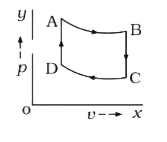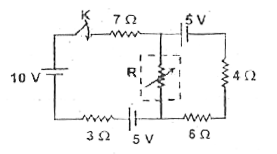Assertion :- On cooling ,ammonia lirquifies first whereas CO2 requires more cooling.
Reason :- Critical temperatures of ammonia and carbon dioxide are 405.5 K and 304.10 K respectively.
If both assertion and reason are true and reason is the correct explanation of assertion .
If both assertion and reason are true but reason is not the correct explanation of assertion .
If assertion is true but reason is false .
If both assertion and reason are false .
The correct Answer is:A
To solve the given assertion and reason question, we will follow these steps:
Step 1: Understand the Assertion
The assertion states that "On cooling, ammonia liquefies first whereas CO₂ requires more cooling." This means that when both gases are cooled, ammonia will change from gas to liquid at a higher temperature compared to carbon dioxide.
Step 2: Understand the Reason
The reason provided states the critical temperatures of ammonia and carbon dioxide: "Critical temperatures of ammonia and carbon dioxide are 405.5 K and 304.10 K respectively." The critical temperature is the temperature above which a gas cannot be liquefied, regardless of the pressure applied.
Step 3: Analyze the Critical Temperatures
- Ammonia (NH₃) has a critical temperature of 405.5 K.
- Carbon Dioxide (CO₂) has a critical temperature of 304.10 K.
Step 4: Compare the Critical Temperatures
Since ammonia has a higher critical temperature than carbon dioxide, it means that ammonia can be liquefied at a higher temperature compared to carbon dioxide. Therefore, when cooling, ammonia will reach its liquefaction point before carbon dioxide does.
Step 5: Conclusion
Both the assertion and the reason are true:
- The assertion is correct because ammonia liquefies first upon cooling.
- The reason is correct because it explains why ammonia liquefies first due to its higher critical temperature.
Final Answer
Both assertion and reason are true, and the reason is the correct explanation for the assertion.
The assertion states that "On cooling, ammonia liquefies first whereas CO₂ requires more cooling." This means that when both gases are cooled, ammonia will change from gas to liquid at a higher temperature compared to carbon dioxide.
The reason provided states the critical temperatures of ammonia and carbon dioxide: "Critical temperatures of ammonia and carbon dioxide are 405.5 K and 304.10 K respectively." The critical temperature is the temperature above which a gas cannot be liquefied, regardless of the pressure applied.
- Ammonia (NH₃) has a critical temperature of 405.5 K.
- Carbon Dioxide (CO₂) has a critical temperature of 304.10 K.
Since ammonia has a higher critical temperature than carbon dioxide, it means that ammonia can be liquefied at a higher temperature compared to carbon dioxide. Therefore, when cooling, ammonia will reach its liquefaction point before carbon dioxide does.
Both the assertion and the reason are true:
- The assertion is correct because ammonia liquefies first upon cooling.
- The reason is correct because it explains why ammonia liquefies first due to its higher critical temperature.
Both assertion and reason are true, and the reason is the correct explanation for the assertion.
Topper's Solved these Questions
- STATES OF MATTER BOOK - NCERT FINGERTPS ENGLISHCHAPTER - STATES OF MATTER EXERCISE - Intermolecular Forces
4 Videos
- STATES OF MATTER BOOK - NCERT FINGERTPS ENGLISHCHAPTER - STATES OF MATTER EXERCISE - Intermolecular Forces Vs Thermal Interactions
2 Videos
- STATES OF MATTER BOOK - NCERT FINGERTPS ENGLISHCHAPTER - STATES OF MATTER EXERCISE - NCERT (EXEMPLAR PROBLEMS)
11 Videos
- SOME BASIC CONCEPTS OF CHEMISTRY BOOK - NCERT FINGERTPS ENGLISHCHAPTER - SOME BASIC CONCEPTS OF CHEMISTRY EXERCISE - NCERT Exemplar
11 Videos
- STRUCTURE OF ATOM BOOK - NCERT FINGERTPS ENGLISHCHAPTER - STRUCTURE OF ATOM EXERCISE - Assertion And Reason
15 Videos
Similar Questions
Gases possess characteristic critical temperature which depends upon the magnitude of intermolecular forces between the gas particles. Critical temperatures of ammonia and carbon dioxide are 405.5 K and 304.10 K respectively. Which of these gases will liquify first when you start cooling from 500 K to their critical temperature ?
View SolutionGases possess characteristic critical temperature which depends upon the magnitude of intermolecualr forces between the gas particles, critical temperatures of ammonia and carbon dioxide are 405.5 K and 304.10 K respectively. Which of these gases will liquefy first when you start cooling from 500 K to their critical temperature ?
View SolutionAssertion : NH3 is liquidities more easily than CO2.
Reason : Critical temperature of NH3 is more than CO2.
View SolutionAssertion : CO2 gas stronger intermolecular forces than CH4
Reason : Critical temperature of CO2 is more.
View SolutionAssertion : Critical temperature of CO2 is 304K, it cannot be liquefied above 304 K.
Reason : At a certain temperature, volume ∝1/ pressure.
View SolutionA solution containing 0.1 mol of naphthalene and 0.9 mol of benzene is cooled out until some benzene freezes out. The solution is then decanted off from the solid and warmed upto 353K where its vapour pressure was found to be 670mm. The freezing point and boiling point of benzene are 278.5K and 353K respectively, and its enthalpy of fusion is 10.67KJmol−1. Calculate the temperature to which the solution was cooled originally and the amount of benzene that must have frozen out. Assume ideal behaviour.
View SolutionA : CaCO3 requires more temperature than MgCO3 for decomposition.
R : Group II metal carbonates on decomposition gives respective oxide and CO2
View SolutionAssertion At triple point, three stated (solid, liquid and gas) may co-exist simulaneously.
Reason For water, the values of pressur and temperature corresponding to triple point are 10 mm of Hg and 273.16 K.
View SolutionOne mole of a monatomic ideal gas is taken through the cycle shown in the figure: A→B adiabatic expansion

B→C: cooling at constant volume
C→D adiabatic compression D→A: heating at constant volume.
The pressure and temperature at PA,PB etc. TA,TB etc. are denoted etc. respectively. Given that
TA=1000K,PB=(2/3)PA and PC=(1/3)PA
Calculate the following quantities.
The temperature TD (in K) [Given : (25)2/5=0.85 ]
View SolutionIn the circuit shown the resistance R is kept in a chamber whose temperature. is 20∘C which remains constant. The initial temperature and resistance of R is 50∘C and 15Ωrespectively. The rate of change of resistance R with temperature is 12Ω/∘C and the rate of decrease of temperature of R is In(3/100) times the temperature difference from the surrounding (Assume the resistance R loses heat only in accordance with Newton's law of cooling) If K is closed at t = 0, then find the
(a) value of. R for which power dissipation in it is maximum.
(b) temperature of R when power dissipation is maximum
(c) time after which the power dissipation will be maximum

View Solution
